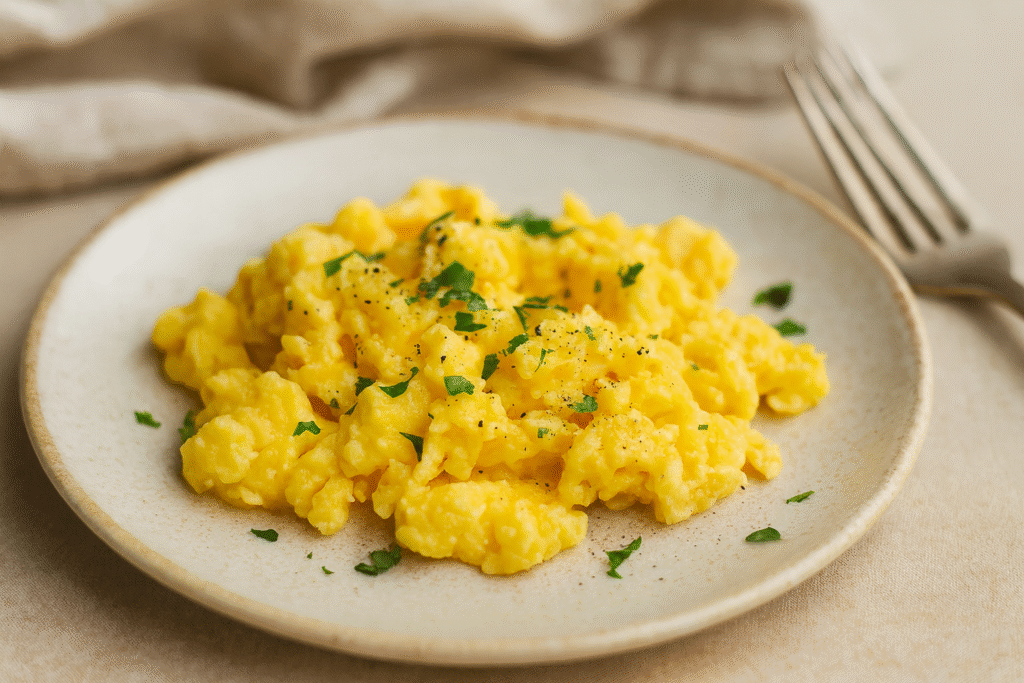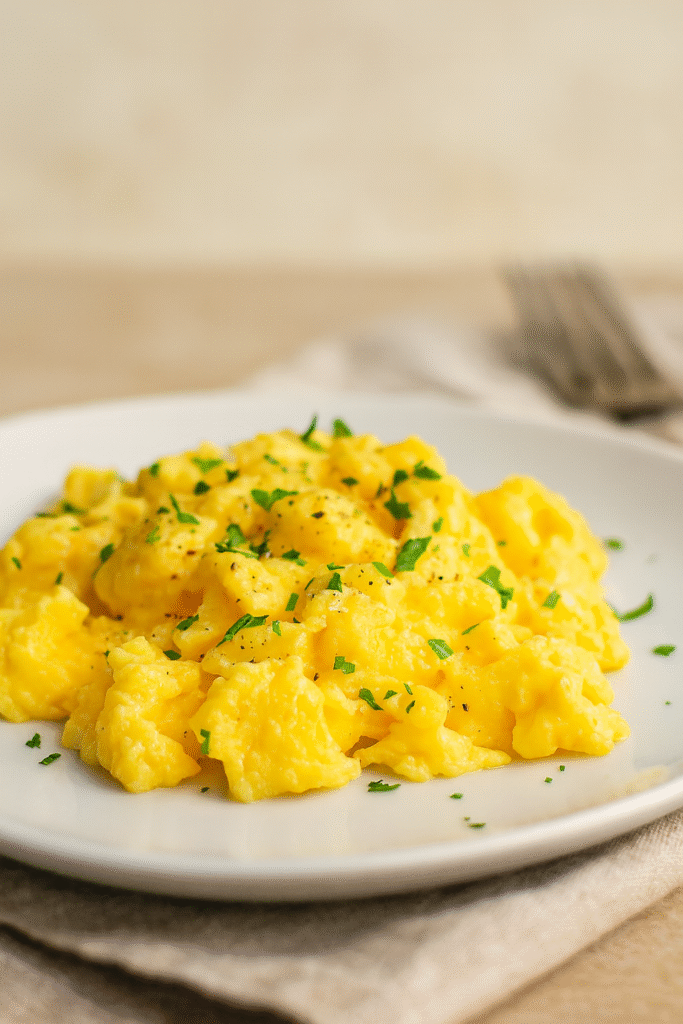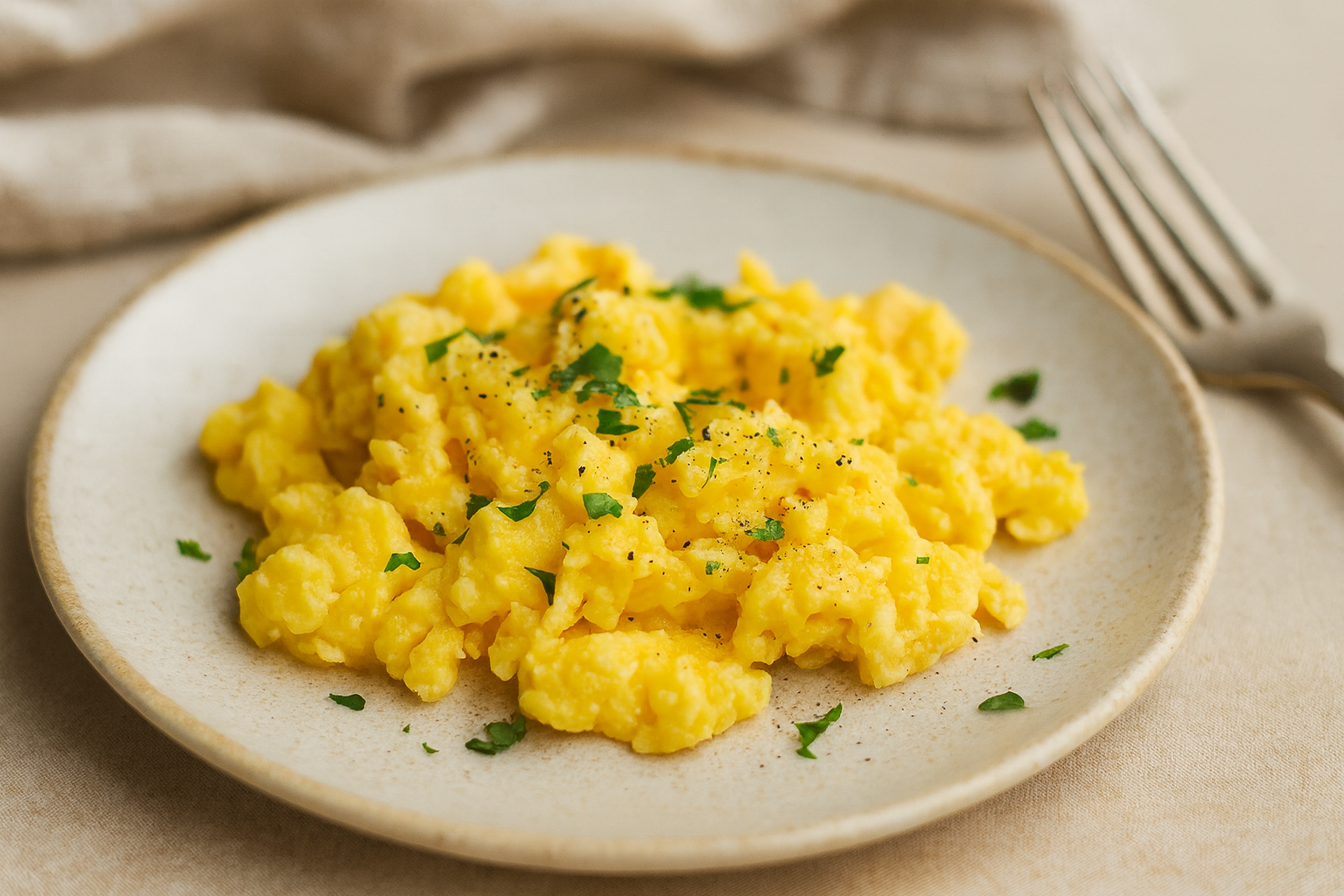
Scrambled eggs are the ultimate comfort food—simple, satisfying, and ready in minutes. Whether you’re starting your day or whipping up a quick dinner, fluffy scrambled eggs hit the spot every time. But not all scrambled eggs are created equal. This recipe shows you how to make them light, airy, and full of flavor using everyday ingredients—no cream, bacon, or alcohol-based ingredients needed.
Perfect for beginners and seasoned cooks alike, these eggs are naturally low-carb, gluten-free, and protein-packed. Serve them with toast, in wraps, or enjoy them on their own. Once you master this method, you’ll never settle for dry or rubbery eggs again.
Why You’ll Love This Fluffy Scrambled Eggs
These scrambled eggs are everything you want in a quick meal: fluffy, light, flavorful, and totally customizable. They come together fast—just 10 minutes—and use ingredients you likely already have. No heavy cream or processed extras required.
You can keep them simple or add herbs, cheese, or veggies to suit your taste. They’re also a great option for low-carb and keto lifestyles. Whether it’s breakfast, lunch, or a late-night bite, these eggs deliver every time.
Soft, satisfying, and made with clean ingredients—this is the go-to scrambled egg recipe you’ll keep coming back to.
What You’ll Need
To make these fluffy scrambled eggs, you only need a handful of basic kitchen staples. Each ingredient plays a role in texture and flavor, and you can easily customize them based on your preferences. Here’s what you’ll need:
Core Ingredients:
- Large eggs – 4 (use fresh, room temperature eggs for best results)
- Whole milk – 2 tablespoons (adds moisture and softness without making the eggs watery)
- Salt – ¼ teaspoon (to enhance flavor)
- Ground black pepper – ⅛ teaspoon (for a mild kick)
- Butter – 1 tablespoon (unsalted preferred, for a creamy finish)
Optional Add-Ins:
- Shredded cheese – ¼ cup (cheddar, mozzarella, or Swiss work well)
- Fresh herbs – 1 tablespoon chopped (chives, parsley, or dill)
- Sautéed vegetables – like spinach, mushrooms, or bell peppers
This recipe focuses on simplicity, but these add-ins allow you to make the eggs your own. Stick to whole, non-processed ingredients and avoid items like bacon or cured meats if you’re aiming for a clean, wholesome meal.
How to Make Fluffy Scrambled Eggs
Step 1: Whisk the Eggs
Crack 4 large eggs into a mixing bowl. Add 2 tablespoons of milk, ¼ teaspoon salt, and ⅛ teaspoon black pepper. Whisk thoroughly until the mixture is smooth and slightly frothy—this adds air, which helps create that fluffy texture.
Step 2: Heat the Pan
Place a nonstick skillet over medium-low heat. Add 1 tablespoon of butter and let it melt slowly, coating the pan evenly. Lower heat helps cook the eggs gently and evenly without browning.
Step 3: Cook Slowly
Pour the egg mixture into the pan. Let it sit for a few seconds until the edges start to set. Using a spatula, gently push the eggs from the edges toward the center. Keep the motion slow and steady—don’t stir constantly.
Step 4: Remove at the Right Time
Once the eggs are mostly set but still slightly glossy, remove the pan from heat. The residual heat will finish the cooking process. If desired, fold in ¼ cup shredded cheese or herbs at this point.
Step 5: Serve Immediately
Transfer the eggs to a plate and serve while warm. Pair with toast, avocado, or fresh fruit for a balanced meal.

You Must Know
Great scrambled eggs come down to a few essential tips:
- Use fresh eggs – They cook better and taste richer.
- Cook low and slow – High heat makes eggs dry and rubbery.
- Pre-season your eggs – Salt enhances texture and flavor when added before cooking.
- Don’t overmix – Whisk until just combined; too much air can lead to dense eggs.
- Use a nonstick pan – It prevents sticking and keeps cleanup easy.
- Take off heat early – Eggs continue cooking from residual heat—remove them while they’re still a bit glossy.
Master these basics, and your scrambled eggs will always be soft, fluffy, and perfectly seasoned.
Perfecting the Cooking Process
To nail fluffy scrambled eggs, technique matters:
- Heat a nonstick skillet over low to medium-low.
- Melt 1 tbsp butter until it’s just liquified—not browned.
- Pour in the whisked eggs and let them sit for a few seconds.
- Gently push the edges inward using a spatula. Let curds form—don’t stir constantly.
- Remove from heat when the eggs look slightly wet—they’ll finish cooking off-heat.
- Fold in extras like cheese or herbs just before serving.
Slow cooking + gentle movement = creamy, fluffy eggs every time.
Add Your Touch Fluffy Scrambled Eggs
Scrambled eggs are incredibly versatile—you can easily customize them to fit your taste or diet.
Try These Add-Ins:
- Cheese: Cheddar, mozzarella, feta, or goat cheese.
- Fresh herbs: Chives, parsley, dill, or basil.
- Veggies: Sautéed spinach, mushrooms, tomatoes, or bell peppers.
- Protein: Diced cooked chicken, turkey, or plant-based sausage.
Want a spicy kick? Add red pepper flakes or a dash of hot sauce. Prefer a creamy texture? Stir in a spoonful of cottage cheese or plain Greek yogurt just before serving.
Keep your mix-ins simple and add them after cooking to keep the eggs fluffy and moist.
Storing & Reheating
Scrambled eggs are best fresh, but you can store leftovers, too.
To Store:
- Let eggs cool fully.
- Place in an airtight container.
- Refrigerate for up to 3 days.
To Reheat:
- Warm in a nonstick pan over low heat.
- Stir gently until just heated through.
- Or microwave in 15-second intervals, stirring in between to avoid overcooking.
Pro tip: Add a splash of milk or water before reheating to restore moisture.
Chef’s Helpful Tips for Fluffy Scrambled Eggs
Want next-level scrambled eggs? Keep these expert tips in mind:
- Start with room temperature eggs – They whisk more easily and cook evenly.
- Use a rubber or silicone spatula – It’s gentle and perfect for folding eggs.
- Avoid metal pans – Nonstick is best for delicate eggs and easy cleanup.
- Watch the heat – Even medium heat can be too much. Stick to low for better control.
- Add butter at the end – Folding in a small pat of cold butter off the heat adds silkiness.
Most important? Be patient. Scrambling eggs slowly is the secret to fluffy perfection.
FAQ for Fluffy Scrambled Eggs
Can I make scrambled eggs without milk?
Yes! Milk is optional. You can use water or skip liquid altogether for firmer eggs.
What’s the best pan to use?
A nonstick skillet is ideal. It prevents sticking and lets you cook with less fat.
Why are my scrambled eggs rubbery?
Overcooking or using high heat causes rubbery eggs. Always cook low and slow.
Can I freeze scrambled eggs?
Technically yes, but texture changes. For best quality, stick to storing in the fridge for up to 3 days.
How can I add more flavor without salt?
Try fresh herbs, a squeeze of lemon juice, nutritional yeast, or salt-free seasoning blends.
Conclusion
Scrambled eggs may be simple, but when made right, they’re anything but boring. With just a few ingredients and the right technique, you can turn plain eggs into a fluffy, flavorful, satisfying dish—perfect for any time of day. Whether you keep it classic or dress it up with herbs, cheese, or veggies, this go-to recipe delivers every time.
Remember: cook low and slow, stir gently, and remove from heat before they fully set. These small habits make all the difference between dry eggs and that soft, creamy texture you’ll crave again and again.
Now that you’ve got the method down, it’s time to grab your skillet and enjoy the best scrambled eggs you’ve ever made—fluffy, light, and totally customizable. Happy cooking!

How to Make Fluffy & Light Scrambled Eggs Every Time
Description
Start your day right with these fluffy, light scrambled eggs. Quick to make and endlessly customizable, they’re perfect for breakfast, brunch, or a simple anytime meal.
Ingredients
Instructions
In a bowl, whisk eggs, milk, salt, and pepper until smooth and slightly frothy.
Heat butter in a nonstick skillet over medium-low heat until melted.
Pour in egg mixture and let it sit for a few seconds.
Gently push eggs from edges toward center with a spatula, cooking slowly and stirring occasionally.
Remove from heat when eggs are still slightly soft and glossy; they’ll finish cooking off the heat.
Serve immediately with your favorite toppings.
Notes
- Use fresh, room-temperature eggs for best texture.
Cook on low heat to avoid rubbery eggs.
Add cheese or herbs at the end for extra flavor.
Avoid overcooking; eggs continue to cook after removal from heat.

